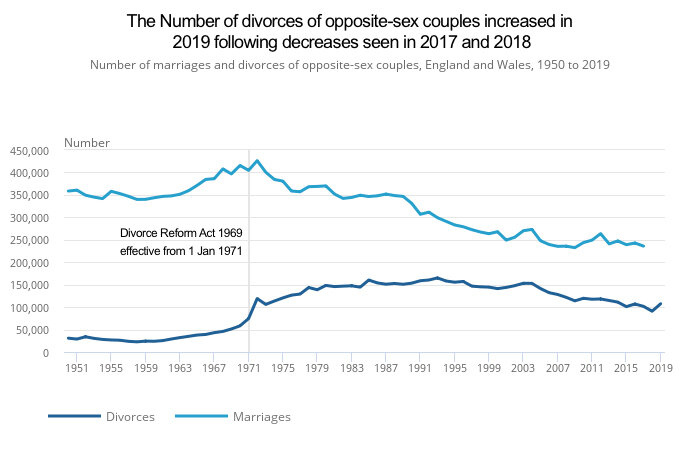Is divorce on the rise? The latest marriage and divorce statistics explained
With major changes to our social lives and divorce legislation on the horizon, we investigate the latest UK marriage and divorce statistics, answering some of the key questions and debunking some of the preconceptions about divorce in the UK and abroad.
Is divorce on the rise?
In 2019, there were 107,599 opposite-sex divorces, an increase of 18.4% on previous years, this was the largest annual percentage increase in divorces since 1972. Following legislative divorce reform - and with many couples forced together during lockdown, the Independent reported that divorce enquiries to law firms increased by 95% during the pandemic (though dropping rates were reported across the Atlantic by the New York Times).
But does this give an accurate view of divorce rates? In reality, the number of divorces has been in an overall downward trend, consistent with the decrease in marriages. In fact, it is most likely that the recent divorce statistics have only increased compared to previous years due to the backlog in processing divorce matters.
Why are marriage numbers down?
Marriage rates for opposite-sex couples were at the lowest on record in 2018, the most recent year data is available for.
There are many reasons for the decreased interest in marriage, including:
Changing attitudes towards marriage as an institution
Increased interest in cohabitation
The opening of civil partnerships to opposite sex couples
Couples choosing to marry later in life
Whilst marriage rates have generally fallen, they have increased in older people in England and Wales. The number of over 65 opposite-sex couples marrying increased by 46% in the decade up to 2014. As older people look forward to a longer life expectancy, and find more opportunities to connect, the number of marriages has steadily increased.
In fact, many are choosing to marry later in life. In the period 2008 to 2018, men and women under 20 recorded the largest percentage of decreases in marriage (57.1% for men and 62.5% for women). The average (mean) age of marriage for opposite-sex couples was 38.1 years for men and 35.8 years for women, in 2018. By comparison, in the mid-1970s, 77% of women were married by the age of 25.
What does this mean?
Shifting attitudes in society has resulted in more acceptance of divorce, allowing for the initial increase in uptake in the 1970s. However, increased cohabitation and older ages before marriage may be contributing to the more recent decline in numbers. Although much negative press is given over the fact that 42% of marriages end in divorce, with around half of those within the first 10 years, these numbers have been slowly decreasing.
With the introduction of the Divorce, Dissolution and Separation Act 2020 in April 2022, hopes are that divorce will become a less acrimonious and painful process. New ‘no fault’ divorce legislation is a huge, timely change to the way we see divorce from a legal perspective in this country. And with our changing views of marriage and commitment, many are perhaps more prepared when they enter into a marriage in the first place.
How can we help?
You can find out more about the changes to UK divorce legislation here. We know that divorce and dissolution can be a stressful and confusing process, and at Ribet Myles we’re here to help you every step of the way. We’re committed to helping, advising, and dealing with proceedings efficiently and sensitively to bring about the best possible outcome.
If you are considering divorce or dissolution, we are able to provide advice about the process and dealing with the issuing and progressing of undefended and (rarely) defended proceedings. Almost all our cases are dealt with by agreement. Feel free to email a member of the team directly or contact us at enquiries@ribetmyles.co.uk You can call us on +44 (0)20 7242 6000 and ask to speak to Cassandra Patten who can then direct your call to a member of the team.


